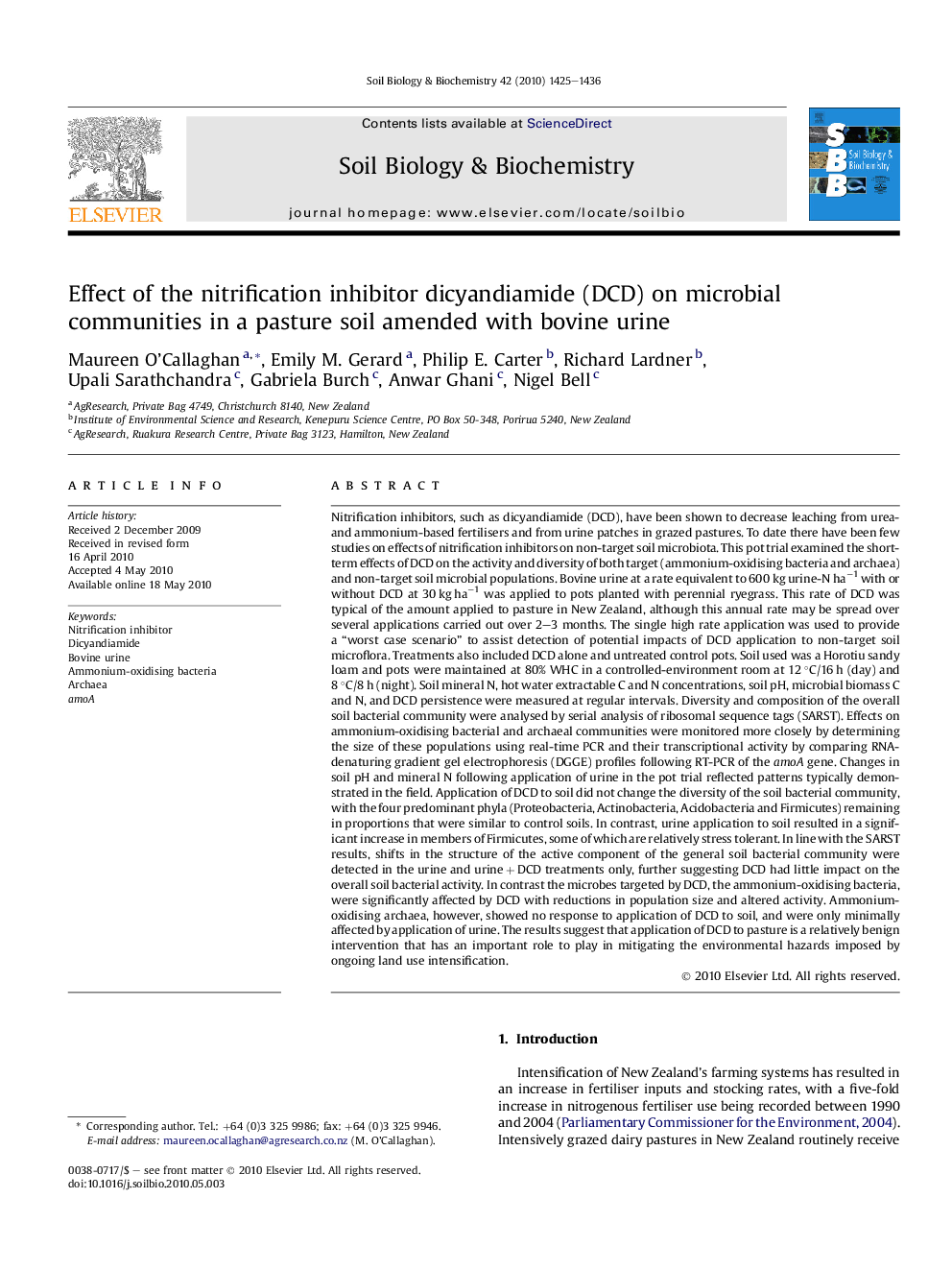| کد مقاله | کد نشریه | سال انتشار | مقاله انگلیسی | نسخه تمام متن |
|---|---|---|---|---|
| 10846111 | 1070002 | 2010 | 12 صفحه PDF | دانلود رایگان |
عنوان انگلیسی مقاله ISI
Effect of the nitrification inhibitor dicyandiamide (DCD) on microbial communities in a pasture soil amended with bovine urine
دانلود مقاله + سفارش ترجمه
دانلود مقاله ISI انگلیسی
رایگان برای ایرانیان
کلمات کلیدی
موضوعات مرتبط
علوم زیستی و بیوفناوری
علوم کشاورزی و بیولوژیک
دانش خاک شناسی
پیش نمایش صفحه اول مقاله

چکیده انگلیسی
Nitrification inhibitors, such as dicyandiamide (DCD), have been shown to decrease leaching from urea- and ammonium-based fertilisers and from urine patches in grazed pastures. To date there have been few studies on effects of nitrification inhibitors on non-target soil microbiota. This pot trial examined the short-term effects of DCD on the activity and diversity of both target (ammonium-oxidising bacteria and archaea) and non-target soil microbial populations. Bovine urine at a rate equivalent to 600 kg urine-N haâ1 with or without DCD at 30 kg haâ1 was applied to pots planted with perennial ryegrass. This rate of DCD was typical of the amount applied to pasture in New Zealand, although this annual rate may be spread over several applications carried out over 2-3 months. The single high rate application was used to provide a “worst case scenario” to assist detection of potential impacts of DCD application to non-target soil microflora. Treatments also included DCD alone and untreated control pots. Soil used was a Horotiu sandy loam and pots were maintained at 80% WHC in a controlled-environment room at 12 °C/16 h (day) and 8 °C/8 h (night). Soil mineral N, hot water extractable C and N concentrations, soil pH, microbial biomass C and N, and DCD persistence were measured at regular intervals. Diversity and composition of the overall soil bacterial community were analysed by serial analysis of ribosomal sequence tags (SARST). Effects on ammonium-oxidising bacterial and archaeal communities were monitored more closely by determining the size of these populations using real-time PCR and their transcriptional activity by comparing RNA-denaturing gradient gel electrophoresis (DGGE) profiles following RT-PCR of the amoA gene. Changes in soil pH and mineral N following application of urine in the pot trial reflected patterns typically demonstrated in the field. Application of DCD to soil did not change the diversity of the soil bacterial community, with the four predominant phyla (Proteobacteria, Actinobacteria, Acidobacteria and Firmicutes) remaining in proportions that were similar to control soils. In contrast, urine application to soil resulted in a significant increase in members of Firmicutes, some of which are relatively stress tolerant. In line with the SARST results, shifts in the structure of the active component of the general soil bacterial community were detected in the urine and urine + DCD treatments only, further suggesting DCD had little impact on the overall soil bacterial activity. In contrast the microbes targeted by DCD, the ammonium-oxidising bacteria, were significantly affected by DCD with reductions in population size and altered activity. Ammonium-oxidising archaea, however, showed no response to application of DCD to soil, and were only minimally affected by application of urine. The results suggest that application of DCD to pasture is a relatively benign intervention that has an important role to play in mitigating the environmental hazards imposed by ongoing land use intensification.
ناشر
Database: Elsevier - ScienceDirect (ساینس دایرکت)
Journal: Soil Biology and Biochemistry - Volume 42, Issue 9, September 2010, Pages 1425-1436
Journal: Soil Biology and Biochemistry - Volume 42, Issue 9, September 2010, Pages 1425-1436
نویسندگان
Maureen O'Callaghan, Emily M. Gerard, Philip E. Carter, Richard Lardner, Upali Sarathchandra, Gabriela Burch, Anwar Ghani, Nigel Bell,